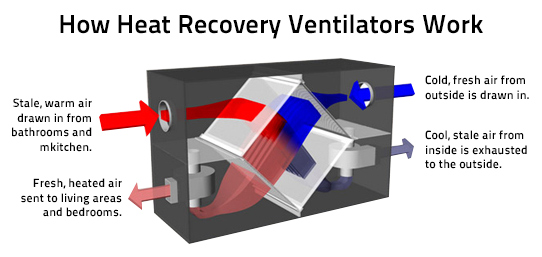The Future of HRV in Energy-Efficient Home Design
Wiki Article
The All-Inclusive Overview to the Uses of Heat Recovery Ventilation in Modern Buildings
Heat Recovery Ventilation (HRV) systems stand for a significant development in building innovation (HRV Heat Recovery Ventilation). They supply a technique for trading stale interior air with fresh exterior air while minimizing energy loss. This method not just improves indoor air quality but likewise contributes to power effectiveness in both property and commercial structures. Comprehending the various applications and advantages of HRV can reveal its essential function in contemporary design and sustainability efforts. The effects of this technology deserve checking out furtherComprehending Heat Recovery Ventilation Equipments

Many modern-day buildings focus on energy efficiency, recognizing warmth healing air flow (HRV) systems is important for maximizing interior air quality and decreasing energy intake. HRV systems function by transferring warm from stale interior air to inbound fresh air, successfully preserving comfy indoor temperatures while lessening power loss. These systems consist of a warmth exchanger, fans, and ductwork that help with the flow of air. Throughout winter, HRV systems catch and reuse warm from the outgoing air, while in summer, they can help cool down inbound air. By continually trading air, HRV systems likewise minimize moisture and the concentration of indoor pollutants. Correct setup and upkeep of HRV systems are essential for their efficiency and efficiency in boosting overall structure efficiency and convenience.
Advantages of Heat Recovery Ventilation
Heat recovery ventilation systems use various advantages that improve both power performance and indoor air top quality in modern-day structures. By recording and recycling power from exhaust air, these systems substantially reduce heating and air conditioning costs, causing reduced energy usage. They preserve a consistent flow of fresh outdoor air, lessening the threat of interior air pollutants and allergens. This constant exchange helps control humidity degrees, stopping mold development and ensuring a healthier living setting. In addition, HRV systems add to sustainability objectives by decreasing total carbon footprints. Their ability to enhance ventilation without compromising thermal comfort makes them a beneficial enhancement to modern building layout, advertising both economic and ecological benefits.Applications of HRV in Residential Buildings
As homeowners progressively prioritize power effectiveness and interior air quality, the applications of heat recuperation air flow (HRV) systems in residential buildings have actually ended up being extra prevalent. HRV systems are particularly beneficial in tightly sealed homes, where maintaining fresh air circulation is vital for stopping dampness build-up and interior toxins. They efficiently transfer warmth from outbound stagnant air to incoming fresh air, lowering power expenses connected with home heating and air conditioning. Additionally, HRVs can enhance convenience levels by managing moisture and temperature level. They are also versatile for various property designs, consisting of single-family homes and multi-unit buildings. Overall, integrating HRV systems supports lasting living practices while ensuring a much healthier interior atmosphere for passengers.HRV in Business and Industrial Settings
In commercial and industrial setups, the execution of warmth recovery air flow (HRV) systems has ended up being increasingly important for enhancing power performance and maintaining air top quality. These systems efficiently move warm from exhaust air to inbound fresh air, minimizing the requirement for added heating or air conditioning. This not just decreases power expenses but also adds to sustainability campaigns. Industries such as manufacturing, warehousing, and workplace buildings profit substantially from HRV systems, as they help control temperature level and humidity levels, guaranteeing a comfortable and effective atmosphere. HRV systems help in getting rid of pollutants and excess dampness, boosting interior air quality. As regulations around air top quality end up being click resources stricter, the fostering of HRV technology is most likely to expand, making it a vital component of modern-day commercial and industrial infrastructure.Future Trends in Heat Recovery Ventilation Technology

Often Asked Inquiries
Exactly How Does Heat Recovery Ventilation Influence Indoor Air Top Quality?
Heat recovery ventilation substantially boosts interior air top quality by constantly exchanging stale indoor air with fresh exterior air about his while recouping power. This procedure decreases pollutants, keeps excellent humidity degrees, and guarantees a much healthier atmosphere for owners.Can HRV Solutions Be Mounted in Existing Buildings?
HRV systems can undoubtedly be installed in existing structures. Retrofitting may require adjustments to ductwork and ventilation designs, yet it considerably enhances energy performance and indoor air high quality, making it a practical option for older structures.What Upkeep Is Required for HRV Systems?

Are There Specific Climates Where HRV Is Much More Effective?
Heat recovery ventilation systems are specifically effective in environments with significant temperature differences in between seasons. These systems maximize power performance by recuperating heat from exhaust air, making them excellent for both chilly and moderately warm settings.Exactly How Do HRV Equipments Affect Energy Bills?

Report this wiki page